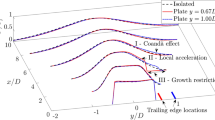Abstract.
The wall shear rate from a rotating cylinder in a uniform flow was measured with flush-mounted electrochemical mass transfer probes. The experiments were performed using two rectangular electrodes in a sandwich arrangement. Initially, the frequency response of that probe was numerically studied using an inverse mass transfer method in order to restore the whole wall shear stress in the time domain starting from the measured transfer coefficients given by the split probe. The experiments were performed in the range of velocity ratios 0<α<5.7 (α is the ratio of the peripheral velocity to free-stream velocity) and for subcritical freestream-Reynolds numbers 10,200<Re<85,300. The use of a sandwich probe permits the estimation of the position of the separation point on the downstream moving wall. It is shown that when α>4, points of zero shear stress on the rotating cylinder vanish, which is in fact consistent with the previous arguments that the cylinder is surrounded by a set of closed streamlines. This experimental study shows that, when their dynamic behaviour is known, the electrochemical probes are able to sense complex fine structures not observed up to now by previous analytical, numerical or experimental methods, even when non-linear effects are not negligible.
Similar content being viewed by others
Author information
Authors and Affiliations
Additional information
Electronic Publication
Rights and permissions
About this article
Cite this article
Labraga, .L., Bourabaa, .N. & Berkah, .T. Wall shear stress from a rotating cylinder in cross flow using the electrochemical technique. Exp Fluids 33, 488–496 (2002). https://doi.org/10.1007/s00348-002-0504-x
Received:
Accepted:
Issue Date:
DOI: https://doi.org/10.1007/s00348-002-0504-x




